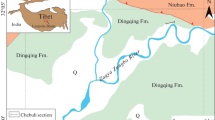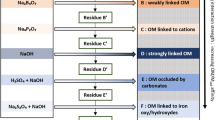Abstract
Three protocols for the determination of inorganic and organic sulfur fractions were tested for their suitability to estimate total indigenous organic sulfur (Sorg) and35Sorg formed from added35SO4 2− in sediments of chemically dilute lakes in the ELA. The protocols tested have all been reported in the literature. It was found that two protocols involving sequential analyses for S fractions following acid treatment gave estimates of both Sorg and35Sorg up to 87% lower than a non-sequential protocol. The low estimates were largely due to hydrolysis and solubilization of solid phase S which was then removed in a rinsing step. The non-sequential protocol, in which total reduced inorganic sulfur and total sulfur were determined on separate aliquots, is recommended as the most reliable of the three. Individual analyses in this protocol were verified for these lake sediments using a variety of S standards.
Similar content being viewed by others
References
Amaral JA (1991) Sulfate reduction and organic sulfur formation in lake sediments. PhD Thesis, University of Manitoba
Amaral JA, Hesslein RH, Rudd JWM & Fox DE (1989) Loss of total sulfur and changes in sulfur isotopic ratios due to drying of lacustrine sediments. Limnology and Oceanography 34: 1351–1358
Armstrong FAJ & Schindler DW (1971) Preliminary chemical characterization of waters in the Experimental Lakes Area, northwestern Ontario. Journal of the Fisheries Research Board of Canada 28: 171–187
Baker LA, Urban NR, Brezonik PL & Sherman LA (1989) Sulfur cycling in an experimentally acidified lake. In: Saltzman E & Cooper W (Eds) Biogenic Sulfur Cycling in the Environment (pp 70–100). ACS
Behr RS (1985) Sulfur dynamics in an experimentally acidified mire in northwestern Ontario. M.S. Thesis. The University of Manitoba, Winnipeg, MB
Berner RA (1984) Sedimentary pyrite formation: An update. Geochimica et Cosmochimica Acta 48: 605–615
Boulegue J, Lord III CJ & Church TM (1982) Sulfur speciation and associated trace metals (Fe, Cu) in the pore waters of Great Marsh, Delaware. Geochimica et Cosmochimica Acta 46: 453–464
Brown K (1986) Formation of organic sulphur in anaerobic peat. Soil Biology and Biochemistry 18: 131–140
Brunskill GJ, Povoledo D, Graham BW & Stainton MP (1971) Chemistry of surface sediments of sixteen lakes in the Experimental Lakes Area, northwestern Ontario. Journal of the Fisheries Research Board of Canada 28: 277–294
Brunskill GJ & Schindler DW (1971) Geography and bathymetry of selected lake basins, Experimental Lakes Area, northwestern Ontario. Journal of the Fisheries Research Board of Canada 28: 139–155
Canfield DE, Raiswell R, Westrich JT, Reaves CM & Berner RA (1986) The use of chromium reduction in the analysis of reduced inorganic sulfur in sediments and shales. Chemical Geology 54: 149–155
Carignan R & Tessier A (1988) The co-diagenesis of sulfur and iron in acid lake sediments of southwestern Quebec. Geochimica et Cosmochimica Acta 52: 1179–1188
Chanton JP & Martens CS (1985) The effects of heat and stannous chloride addition on the active distillation of acid-volatile sulfide from pyrite-rich marine sediment samples. Biogeochemistry 1: 375–383
Cook RB & Schindler DW (1983) The biogeochemistry of sulfur in an experimentally acidified lake. Ecological Bulletin 35: 115–127
David MB & Mitchell MJ (1985) Sulfur constituents and cycling in waters, seston, and sediments of an oligotrophic lake. Limnology and Oceanography 30: 1196–1207
Ferdelman TG, Church TM & Luther III GW (1991) Sulfur enrichment of humic substances in a Delaware salt marsh sediment core. Geochimica et Cosmochimica Acta 55: 979–988
Fitzgerald JW (1976) Sulfate ester formation and hydrolysis: a potentially important yet often ignored aspect of the sulfur cycle of aerobic soils. Bacteriological Reviews 40: 698–721
Freney JR, Melville GE & Williams CH (1970) The determination of carbon bonded sulfur in soil. Soil Science 109: 310–318
Howarth RW & Merkel S (1984) Pyrite formation and the measurement of sulfate reduction in salt marsh sediments. Limnology and Oceanography 29: 598–608
Howarth RW & Teal JM (1979) Sulfate reduction in a New England salt marsh. Limnology and Oceanography 24: 999–1013
Hsieh YP & Yang CH (1989) Diffusion methods for the determination of reduced inorganic sulfur species in sediments. Limnology and Oceanography 34: 1126–1130
Johnson CM & Ulrich A (1959) Analytical methods for use in plant analysis. California Agricultural Experimental Station Bulletin, 766
Jarvis BJ, Lang GE & Wieder RK (1987) Arylsulphatase activity in peat exposed to acid precipitation. Soil Biology and Biochemistry 19: 107–109
Jorgensen BB & Fenchel T (1974) The sulfur cycle of a marine sediment model system. Marine Biology 24: 189–201
Kelly CA, Rudd JWM, Cook RB & Schindler DW (1982) The importance of bacterial processes in regulating the rate of lake acidification. Limnology and Oceanography 27: 868–882
King GM & Klug MJ (1980) Sulfhydrolase activity in sediments of Wintergreen Lake, Kalamazoo County, Michigan. Applied and Environmental Microbiology 39: 950–956
Krairapanond N, Delaune RD & Patrick JR (1991) Sulfur dynamics in Louisiana coastal freshwater marsh soils. Soil Science 151: 261–273
Landers DH, David MB & Mitchell MJ (1983) Analysis of organic and inorganic sulfur constituents in sediments, soils and water. International Journal of Environmental Chemistry 14: 245–256
Landers DH & Mitchell MJ (1988) Incorporation of35SO4 2− into sediments of three New York lakes. Hydrobiologia 160: 85–95
Luther III GW, Church TM, Scudlark JR & Cosman M (1986) Inorganic and organic sulfur cycling in salt marsh pore waters. Science 232: 746–749
Mitchell MJ, Landers DH, Brodowski DF, Lawrence GB & David MB (1984) Organic and inorganic sulfur constituents of the sediments in three New York lakes: Effect of site, sediment depth and season. Water Air and Soil Pollution 21: 231–245
Morse JW & Cornwell JC (1987) Analysis and distribution of iron sulfide minerals in recent anoxic marine sediments. Marine Chemistry 22: 55–69
Nriagu JO & Soon YK (1985) Distribution and isotopic composition of sulfur in lake sediments of northern Ontario. Geochimica et Cosmochimica Acta 49: 823–834
Richards SR, Kelly CA & Rudd JWM (1991) Organic volatile sulfur in lakes of the Canadian shield and its loss to the atmosphere. Limnology and Oceanography 36: 468–482
Rudd JWM, Kelly CA & Furutani A (1986a) The role of sulfate reduction in long term accumulation of organic and inorganic sulfur in lake sediments. Limnology and Oceanography 31: 1281–1291
Rudd JWM, Kelly CA, St. Louis V, Hesslein RH, Furutani A & Holoka MH (1986b) Microbial consumption of nitric and sulfuric acids in acidified north temperate lakes. Limnology and Oceanography 31: 1267–1280
Rudd JWM, Kelly CA, Schindler DW & Turner MA (1990) A comparison of the acidification efficiencies of nitric and sulfuric acids by two whole-lake addition experiments. Limnol. Oceanogr. 35: 663–679
Sweerts JP, Rudd JWM & Kelly CA (1986) Metabolic activities in flocculent surface sediments and underlying sandy littoral sediments. Limnology and Oceanography 31: 330–338
Tabatabai MA & Bremner JM (1970) An alkaline oxidation method for the determination of total sulfur in soils. Soil Science Society of America Proceedings 34: 62–65
Wada H (1977) The synthesis of greigite from a polysulfide solution at about 100 °C. Bulletin of the Chemical Society of Japan 50: 2615–2617
Wieder RK & Lang GE (1988) Cycling of inorganic and organic sulfur in peat from Big Run Bog, West Virginia. Biogeochemistry 5: 221–242
Wieder RK, Lang GE & Granus VA (1985) An evaluation of wet chemical methods for quantifying sulfur fractions in freshwater wetland peat. Limnology and Oceanography 30: 1109–1114
Zhabina NN & Volkov II (1978) A method for determination of various sulfur compounds in sea sediments and rocks. In Krumbein WE (Ed) Environmental Biogeochemistry and Geomicrobioloy. Vol. 3 (pp 735–745). Ann Arbor Science Publishers, Michigan
Author information
Authors and Affiliations
Rights and permissions
About this article
Cite this article
Amaral, J.A., Kelly, C.A. & Flett, R.J. Measurement of organic-35S and organic-S in lake sediments: Methodological considerations. Biogeochemistry 23, 61–78 (1993). https://doi.org/10.1007/BF00002923
Received:
Accepted:
Issue Date:
DOI: https://doi.org/10.1007/BF00002923




